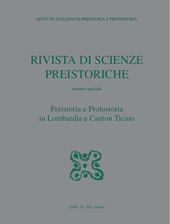I santuari megalitici di Cemmo e Ossimo-Pat : cronologia, organizzazione, rituali ed iconografia
P. 343-354
The excavation of the Cemmo sanctuary, finished in 2013, and the ongoing work at Ossimo-Pat have yielded fascinating evidence concerning the general aspects of Copper Age open-air cult sites, as well as interesting details about the individual locations: – chronology: foundation in the first half of the 4th millennium BC, in use throughout the 3rd, lengthy spells of reuse in the Late Bronze Age and Iron Age (in the case of Cemmo until late Roman times); – organization: large-scale foundation operations aimed at the sanctuaries' visibility and insertion into a “ritual landscape”; regular north-south alignments of engraved monoliths; the connection of these with ceremonial structures and procedures (at Pat cenotaph mounds and votive enclosures, both containing “female” and “male” offerings; at Cemmo plough grooves and a ditch);
the interment of human bones, articulated (a stone cist tomb on a platform at Ossimo-Pat) and disarticulated (Cemmo); substantial modifications were carried out during the Copper Age, changing the direction of the standing-stone lines; – rituals: complex and unusual rites associated with ancestor cults and the ceremonies periodically held on the sites (knocking down some of the steles, altering and re-engraving monuments; lighting fires; periodically burying objects in special structures or in the ground next to monolith rows); – iconography: the subjects from one sanctuary may be studied and compared to those from the other – and the specific relations of each with larger areas determined;
the Pat excavations furnished interesting evidence regarding the early iconography of the sanctuary, which underwent a thorough reorganization in around the mid-3rd millennium, when many monoliths were knocked over but otherwise left in situ, intact. Our understanding of the histories of these two sites, on the basis of their stratigraphy dated by a series of radiometric determinations, is enriched by the significant objects that were found, made of worked stone, pottery, metal and bone. already present, were never abundant. [Publisher's text]
Forma parte de
Rivista di scienze preistoriche : LXXII, supplemento, 2022-
Artículos del mismo número (disponibles individualmente)
-
Información
Código DOI: 10.32097/1179
ISSN: 2282-457X


